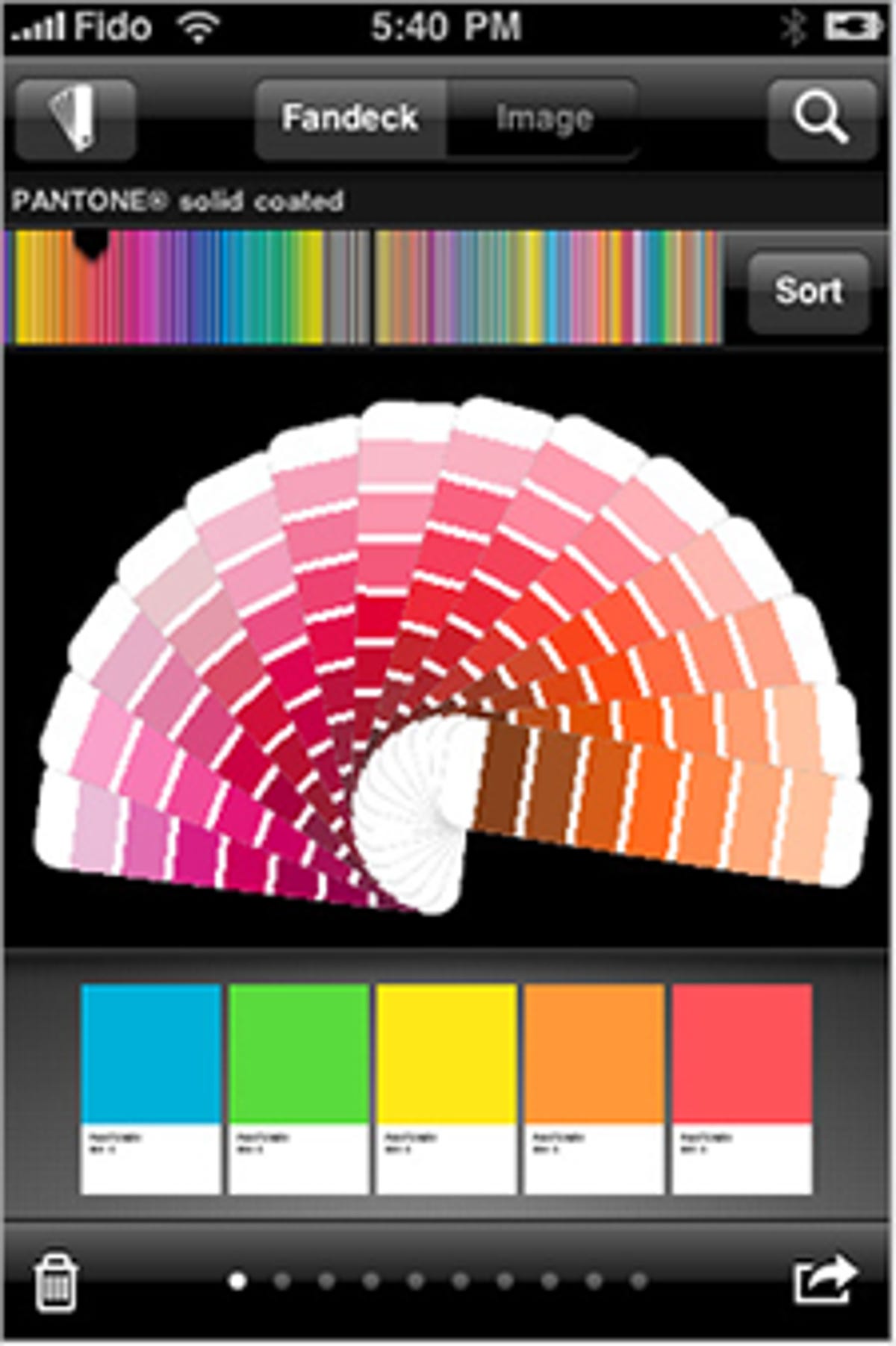Graphic artists who work with Pantone colors may appreciate the latest iPhone offering.
Designed for the iPhone and iPod Touch, the $9.99 MyPantone app lets mobile users create and share palettes of colors drawn from the familiar Pantone libraries.

Pantone
The app opens with a fan deck of Pantone color swatches, a virtual replica of the print Pantone swatch guide that designers carry with them. A color bar also resides at the top.
MyPantone offers colors from virtually all of the standard libraries, including Pantone Matching System (PMS) and Pantone Goe, which provides more color variations than PMS.
To create a palette, move your finger along the colors until you find the swatches you want to use. Clicking on any swatch displays its colors in a more detailed view. You can then drag any color down to the palette well below to store it.
From the fan deck, tapping on a specific color displays its values in Pantone, RGB, HTML (hex), and L*a*b (a color scale that plots values for luminance, red-green, and blue-yellow). From the palette well, tapping on a color brings up additional buttons, including a window that displays a cross-reference of harmonious colors.
You can also create a palette from a photograph. Load any photo stored on your iPhone, and the app will grab its dominant colors and automatically save them to the palette well. You can even move your finger around the photo to select a specific color shade.
Once your palette is created, you can view your colors against a different background rather than just in the palette well. This shows you how the colors might play against each other in an actual image or application.
You can save each color palette in formats compatible with popular graphic apps, including Adobe Creative Suite, QuarkExpress, or CorelDraw. You can also share your palettes by e-mail or by posting them to the MyPantone Web site.
Andy Hatkoff, Pantone’s vice president of technology licensing, recently told me more about MyPantone.
Pantone thought it was important to move to a mobile environment because the company had noticed a shift in the way people work. “Designers, in particular, don’t have to be or don’t want to be at their desks or carry their laptops around them,” said Hatkoff. “But they do take their phones everywhere, in particular their iPhones.”
Pantone felt the iPhone was the right playing field for its first mobile app because, more than any other mobile device, graphic designers probably have iPhones.
MyPantone lets designers take their Pantone library with them. But it’s not meant as a replacement for traditional color guides, more as a supplement. Hatkoff sees the app as playful and fun to use but with a serious side that renders it a useful tool.
“We wanted to let people use the Pantone language in a creative way, but still take advantage of a lot that the iPhone has to offer with a playful and touchable user interface,” said Hatkoff.
MyPantone isn’t the first color palette app for the iPhone. Color Expert from Code Line ($9.99), Palettes ($9.99) by Rick Maddy, and Color Stream ($2.99) from Sahil Lavingia serve up similar features.
The iTunes App store also offers color picker applications, more for homeowners and hobbyists, than for graphic artists. Free apps such as ColorSnap from Sherwin-Williams and Ben Color Capture from Benjamin Moore fit into this group.
But Hatkoff pointed out that most apps don’t support Pantone colors (Color Expert was the only one of the bunch), and that MyPantone is the only one that can display harmonious colors.
MyPantone does have two significant limitations. It doesn’t offer CMYK conversion data, disappointing to people who need to bounce between RGB and CMYK. But Pantone said it’s received requests from many users for CMYK data, and that it’s considering this and other features for the next update.
Also, because it’s on an iPhone, you can’t calibrate colors or adjust for ambient light as you can on a monitor. So the app can’t offer the precise colors that a print swatch or a calibrated monitor would provide.
As a result, Hatkoff explained, MyPantone is not intended to be a color-correct environment, but more of an inspirational or directional use of color. For accuracy, designers would still need to rely on the traditional Pantone guide or a calibrated monitor.
I asked Hatkoff if color calibration and ambient light adjustment would even be possible on an iPhone? “I’m not going to say it would be impossible (to calibrate an iPhone), but it’s something we are certainly investigating,” he said. “We don’t know the feasibility at this point. It certainly would address some interesting questions, although I don’t know if iPhone users would want to calibrate their iPhones.”
Correction 11:35 a.m. PDT: This story initially gave an incorrect title for Andy Hatkoff. He is vice president of technology licensing.



